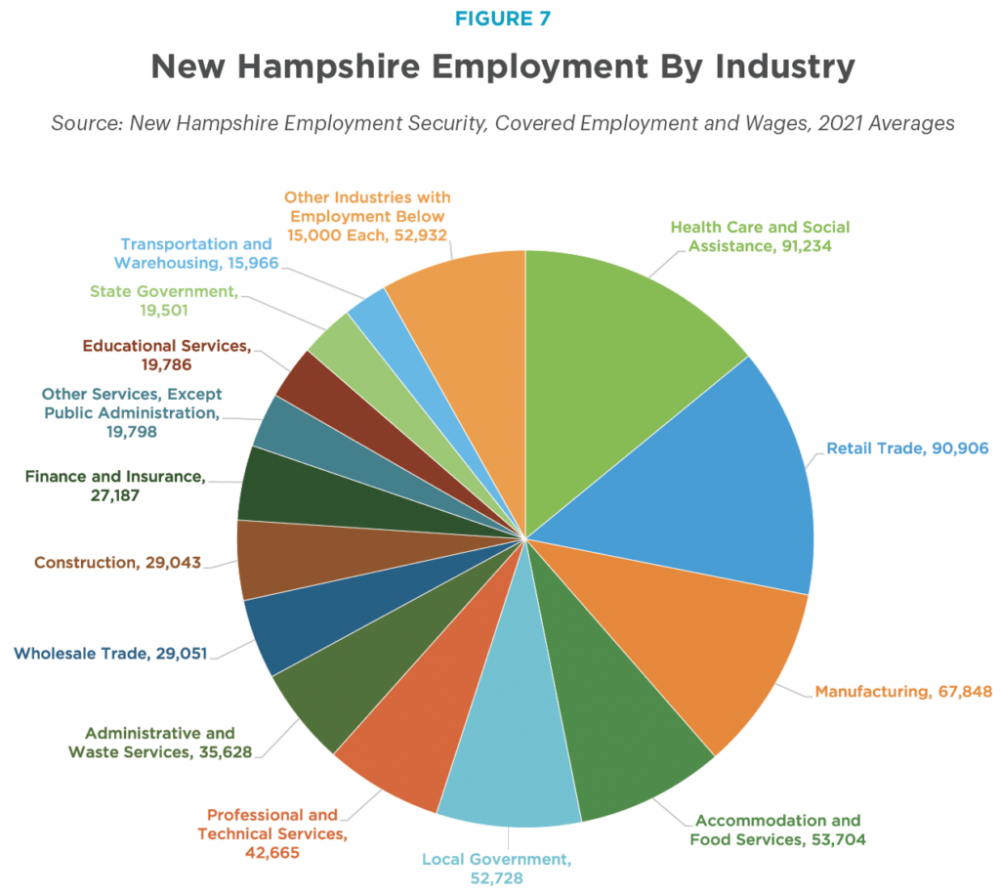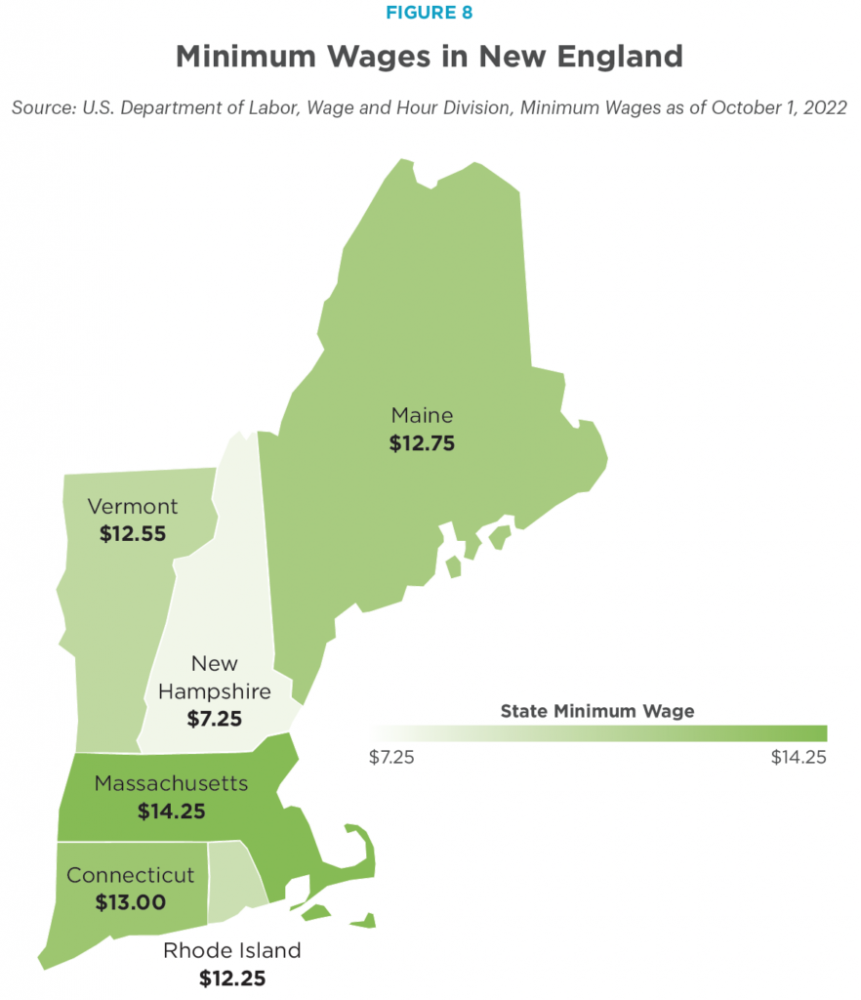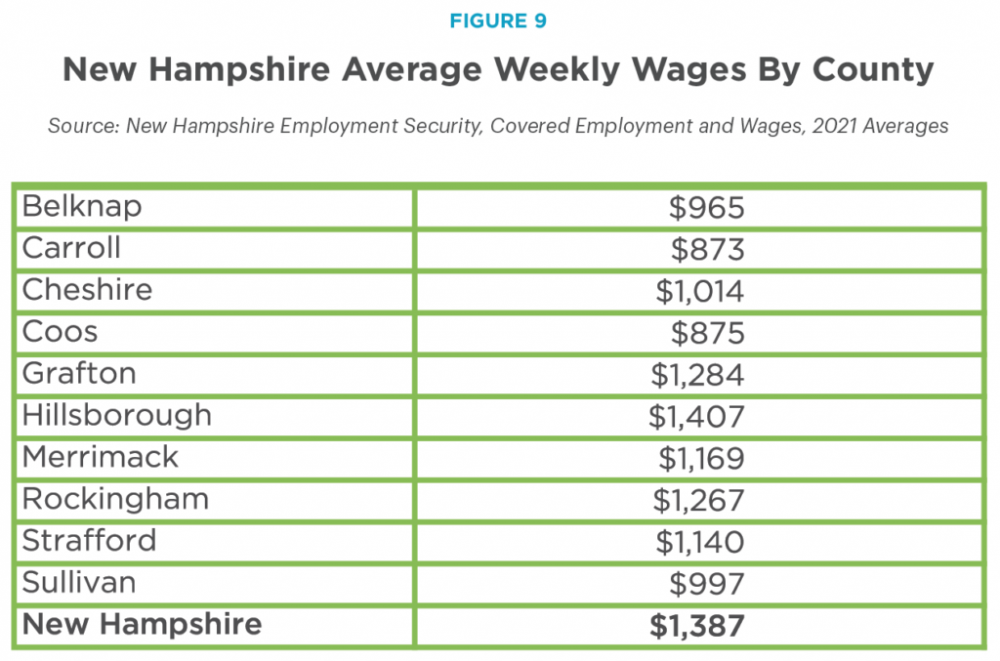This first edition of New Hampshire Policy Points provides an overview of the Granite State and the people who call New Hampshire home. It focuses on some of the issues that are most important to supporting thriving lives and livelihoods for New Hampshire’s residents.
New Hampshire Policy Points is intended to provide an informative and accessible resource to policymakers and the general public alike, highlighting areas of key concern. Touching on some important points but by no means comprehensive, each section within New Hampshire Policy Points includes the most up-to-date information available on each topic area as of October 2022.
The following section, Economy and Jobs, is one of nine sections that frame this resource guide. Other sections cover Population and Demographics, Income and Economic Security, Housing, Health, Education, Broadband Internet, Transportation, and How We Fund Public Services. The facts and figures included within this book provide useful information and references for anyone interested in learning about New Hampshire and contributing to making the Granite State a better place for everyone to call home.
To purchase a print copy or download a free digital PDF of New Hampshire Policy Points, visit nhfpi.org/policypoints.
A thriving economy with well-paying jobs can create prosperity for residents as well as for the state and its communities.
Strong, diverse economies can be more resilient to economic downturns and the negative consequences of failure in a single industry. New Hampshire’s state economy is diverse, relying on an array of distinct industries. As a whole, the Granite State’s largest employment sectors in 2021 were Health Care and Social Assistance, followed by Retail Trade, Manufacturing, Accommodation and Food Services, Local Government, and Professional and Technical Services.
The pie chart shows the number of jobs in each employment sector that are based in the state. These figures do not include the many New Hampshire residents who commute to jobs out of state, such as to metropolitan Boston in neighboring Massachusetts, for more or higher-paying job opportunities. In 2021, approximately 12 percent of employed Granite Staters age 16 and older commuted out of state for work.

Access to job opportunities in neighboring states, particularly in Massachusetts, has had a significant impact on the New Hampshire economy. The relative proximity to metropolitan Boston characteristic of communities in southeastern New Hampshire contributes to higher incomes and more urbanization in those areas, spurring more economic activity and employment growth. While rural areas further north and west in New Hampshire have not benefited as directly from metropolitan Boston, relative ease of access to those areas for tourism and recreation for travelers from other states has impacted local economies.
Wages and Pandemic Impacts
The minimum wage in New Hampshire is the lowest amount an employer can legally pay their employees in most situations. New Hampshire adheres to the federal minimum wage, which was last raised in 2009 and is currently $7.25 per hour. By comparison, every other New England state had a minimum wage of at least $12.25 per hour as of mid-2022. The minimum wage is not adjusted for inflation in New Hampshire or federally. In July 2009, a full-time worker earning the federal minimum wage earned $15,080 annually. However, adjusted to reflect the purchasing power of $15,080 in July 2022, the equivalent purchasing power of the 2022 minimum wage in July 2009 would have been $11,336, as goods and services have become more expensive while the wage has remained the same dollar value.

Of New Hampshire’s five private industries that employed the most residents in 2021, three paid average wages lower than the statewide average wage. While the average reported weekly wage for Professional and Technical Services was $2,251, and Manufacturing employers reported an average weekly wage of $1,551, average weekly wages reported by Retail Trade employers in New Hampshire was $790, and weekly wages averaged $513 for Accommodation and Food Services.
During 2020, employment declined significantly in key industries, including Healthcare and Social Assistance, Retail Trade, Education Services, and Accommodation and Food Services, resulting in lower wages for many people, including younger workers, workers with certain racial and ethnic backgrounds, and workers with lower levels of education, all of whom were disproportionately impacted by the COVID-19 pandemic. Granite Staters with lower wages were also more significantly impacted by the employment and income losses caused by the pandemic. During the long, slow recovery from the Great Recession of 2007–2009, wages for those earning lower and median incomes in New Hampshire took longer to recover than for those earning more, suggesting that these workers were not benefiting equitably from the economy even before the COVID-19 pandemic.
During 2021, the average public and private sector weekly wage in the state was $1,387. The average wage of workers differs by county, with Hillsborough reporting the highest at $1,407, and Carroll the lowest at $873. Some of these differences in county-level average wages are due to higher concentrations of industries that pay workers more, and are more likely to employ workers full time, in some regions than in others.

Unemployment and Workforce Challenges
The COVID-19 pandemic resulted in large declines in overall employment in New Hampshire in 2020. The number of Granite Staters employed in 2019 averaged over 756,300. In 2020, an average of just under 708,600 were employed, while in 2021 the figure rebounded to about 728,900. Workforce participation and the size of the labor force also declined during the pandemic. The size of the labor force, which includes the number of people employed and looking for work, averaged about 776,500 for New Hampshire in 2019. In 2020, it averaged under 759,800 and in 2021 it averaged over 755,400.
Prior to the pandemic, New Hampshire’s unemployment rate was below 3.0 percent every month since December 2015. In April 2020, unemployment peaked at 16.2 percent statewide, and declined throughout the remainder of 2020 and into 2021. In early 2022, the unemployment rate returned to less than 3.0 percent statewide. A different measure of unemployment that, unlike the standard measure, includes discouraged, underemployed, and unemployed workers, showed higher levels of unemployment and labor underutilization in New Hampshire with the average rate for 2019 at 5.2 percent and at 6.1 percent for 2021.
Many workers who have left the labor force and not yet returned have identified issues with child care as a major barrier. A combination of factors, including New Hampshire’s aging population, the health risks exacerbated by the pandemic, and challenges to accessing affordable housing and child care, have resulted in significant declines in labor force participation; the largest declines have been seen among younger adult workers, including those who are of ages that are more likely to have young children, and older workers, who faced substantially increased health risks from the pandemic. The initial employment losses of the pandemic impacted women more dramatically than men, as women were more likely to work in key industries directly disrupted by the pandemic. Women were also more likely to step back from the labor force to fill gaps in child care and family care giving needs.
Of those who have remained in the workforce, many experienced stagnation or decline in their purchasing power. When adjusted for inflation, the average private sector wage in New Hampshire was lower in July 2022 than in July 2020, early in the recovery from the pandemic. Sustained and substantial investments in New Hampshire’s workforce, however, have the potential to help Granite State workers and families get back on their feet and boost the economy.
This publication and its conclusions are based on independent research and analysis conducted by NHFPI. Please email us at info@nhfpi.org with any inquiries or when using or citing New Hampshire Policy Points in any forthcoming publications.
The New Hampshire Fiscal Policy Institute is sharing these articles with the partners in The Granite State News Collaborative.

 Current Issue - April 2024
Current Issue - April 2024